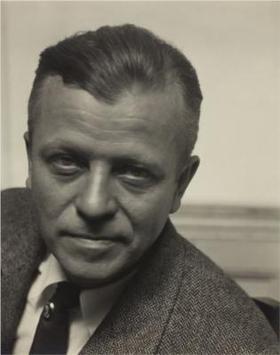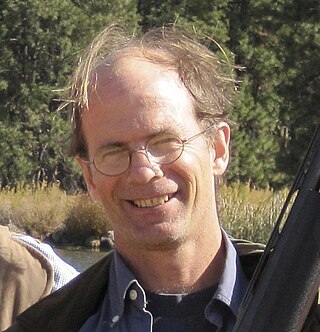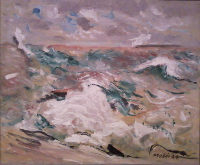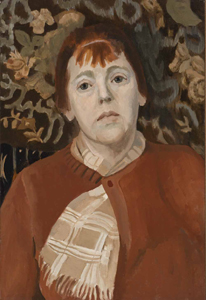
Stanton Macdonald-Wright, was a modern American artist. He was a co-founder of Synchromism, an early abstract, color-based mode of painting, which was the first American avant-garde art movement to receive international attention.

Georgia Totto O'Keeffe was an American modernist artist. She was known for her paintings of enlarged flowers, New York skyscrapers, and New Mexico landscapes. O'Keeffe has been called the "Mother of American modernism".

Max Weber was a Jewish-American painter and one of the first American Cubist painters who, in later life, turned to more figurative Jewish themes in his art. He is best known today for Chinese Restaurant (1915), in the collection of the Whitney Museum of American Art, "the finest canvas of his Cubist phase," in the words of art historian Avis Berman.

Marsden Hartley was an American Modernist painter, poet, and essayist. Hartley developed his painting abilities by observing Cubist artists in Paris and Berlin.

Arthur Garfield Dove was an American artist. An early American modernist, he is often considered the first American abstract painter. Dove used a wide range of media, sometimes in unconventional combinations, to produce his abstractions and his abstract landscapes. Me and the Moon from 1937 is a good example of an Arthur Dove abstract landscape and has been referred to as one of the culminating works of his career. Dove made a series of experimental collages in the 1920s. He also experimented with techniques, combining paints like hand mixed oil or tempera over a wax emulsion as exemplified in Dove's 1938 painting Tanks, in the collection of the Boston Museum of Fine Arts.

Alfred Henry Maurer was an American modernist painter. He exhibited his work in avant-garde circles internationally and in New York City during the early twentieth century. Highly respected today, his work met with little critical or commercial success in his lifetime, and he died, a suicide, at the age of sixty-four.

Arthur Bowen Davies was an avant-garde American artist and influential advocate of modern art in the United States c. 1910–1928.

John Marin was an early American modernist artist. He is known for his abstract landscapes and watercolors.
American modernism, much like the modernism movement in general, is a trend of philosophical thought arising from the widespread changes in culture and society in the age of modernity. American modernism is an artistic and cultural movement in the United States beginning at the turn of the 20th century, with a core period between World War I and World War II. Like its European counterpart, American modernism stemmed from a rejection of Enlightenment thinking, seeking to better represent reality in a new, more industrialized world.

Charles Henry Caffin was an Anglo-American writer and art critic, born in Sittingbourne, Kent, England. After graduating from Magdalen College, Oxford, in 1876, with a broad background in culture and aesthetics, he engaged in scholastic and theatrical work. In 1888, he married Caroline Scurfield, a British actress and writer. They had two children, daughters Donna and Freda Caffin. In 1892, he moved to the United States. He worked in the decoration department of the Chicago Exposition, and after moving to New York City in 1897, he was the art critic of Harper's Weekly, the New York Evening Post, the New York Sun (1901–04), the International Studio, and the New York American. His publications are of a popular rather than a scholarly character, but he was an important early if equivocal advocate of modern art in America. His writings were suggestive and stimulating to laymen and encouraged interest in many fields of art. One of his last books, Art for Life's Sake (1913), described his philosophy, which argued that the arts must be seen as "an integral part of life....[not] an orchid-like parasite on life" or a specialized or elite indulgence. He also argued strenuously for art education in American elementary schools and high schools and was a frequent lecturer.
Josiah McElheny is an artist and sculptor, primarily known for his work with glass blowing and assemblages of glass and mirrored glassed objects. He is a 2006 recipient of the MacArthur Fellows Program. He lives and works in New York City.

Theodoros Stamos was a Greek-American painter. He is one of the youngest painters of the original group of abstract expressionist painters, which included Jackson Pollock, Willem de Kooning and Mark Rothko. His later years were negatively affected by his involvement with the Rothko case.

The Heckscher Museum of Art is named after its benefactor, August Heckscher, who in 1920 donated 185 works of art to be housed in a new Beaux-Arts building located in Heckscher Park, in Huntington, New York. The museum has over 2000 works of art, focused on American landscape paintings and work by Long Island artists, as well as featuring American and European modernism, and photography. The most famous painting in the collection is George Grosz’s “Eclipse of the Sun” (1926).

The Steerage is a black and white photograph taken by Alfred Stieglitz in 1907. It has been hailed as one of the greatest photographs of all time because it captures in a single image both a formative document of its time and one of the first works of artistic modernism.

Julian Burroughs Hatton III is an American landscape abstract artist from New York City. The New York Times described his painting style as "vibrant, playful, semi-abstract landscapes" while New York Sun art critic John Goodrich compared him to French painter Bonnard. Hatton's abstract landscapes have been compared to paintings by Arthur Dove and Georgia O'Keeffe because of his "unbridled love of pure, hot color" similar to Gauguin and the Fauves, according to critic Ann Landi of ARTnews. Hatton's vision is of "a nature that you can literally eat with your eyes, eye candy transposed onto the entire world," according to critic Joel Silverstein.

Hurricane is a 1944 oil painting by American artist John Marin, located in the Indianapolis Museum of Art, which is in Indianapolis, Indiana. He used quick brushstrokes and thickly daubed paint to depict a turbulent ocean such as he experienced near his summer home in Maine.

Helen S. "Reds" Torr (1886–1967) was an American early Modernist painter nicknamed "Reds" for her hair color. Torr worked alongside her artist husband Arthur Dove and friend Georgia O'Keeffe to develop a characteristically American style of Modernism in the 1920s.

David Sharpe is an American artist, known for his stylized and expressionist paintings of the figure and landscape and for early works of densely packed, organic abstraction. He was trained at the School of the Art Institute of Chicago and worked in Chicago until 1970, when he moved to New York City, where he remains. Sharpe has exhibited at the Whitney Museum of American Art, Art Institute of Chicago, Museum of Contemporary Art Chicago (MCA), The Drawing Center, Aldrich Museum of Contemporary Art, Indianapolis Museum of Art, and Chicago Cultural Center, among many venues. His work has been reviewed in Art in America, ARTnews, Arts Magazine, New Art Examiner, the New York Times, and the Chicago Tribune, and been acquired by public institutions such as the Art Institute of Chicago, Scottish National Gallery of Modern Art, MCA Chicago, Smart Museum of Art, and Mary and Leigh Block Museum of Art, among many.

William Nichols is an American artist known for highly detailed, tactile landscape paintings that combine physical scale with intimacy. His work depicts unassuming gardens, forests, ponds, and streams rather than grand vistas, in dense, close-up screens of foliage, thicket or water that immerse viewers within the experience rather outside it. Nichols developed his mature style in the 1970s, combining painterly traditions going back to Impressionism with reemerging movements such as Realism and Photorealism; critic John Perreault called his approach, "Photo-Impressionism." He has exhibited throughout the United States and abroad, including at OK Harris Gallery in New York (1979–2013), the San Francisco Museum of Modern Art, Milwaukee Museum of Art, Butler Institute of American Art, Kaohsiung Museum of Fine Arts (Taiwan), and Gulbenkian Museum (Lisbon); his work belongs to many private and public museum collections. In addition to reviews in national publications, Nichols's work appears in several art historical surveys of Realism and landscape painting, including The Artist and the American Landscape and Contemporary American Realism Since 1960, among others. Critic Mac McCloud observed that Nichols's "meticulous craft and precise observation of shape, edge, color and light" rendered his work "almost beyond reality […] alive with growth and transformation, teeming with insects and sweltering weather and yet, in the eternal aesthetic paradox it is motionless." Gallerist Ivan Karp wrote, "the vital pulse" of Nichols's paintings defies "the conviction that 400 years of depictions of the natural world nullify the ability of living artists to produce landscapes of high consequence."

Sentimental Music is a circa 1913 painting by Arthur Dove. It is in the collection of the Metropolitan Museum of Art. It is not currently on display.


















